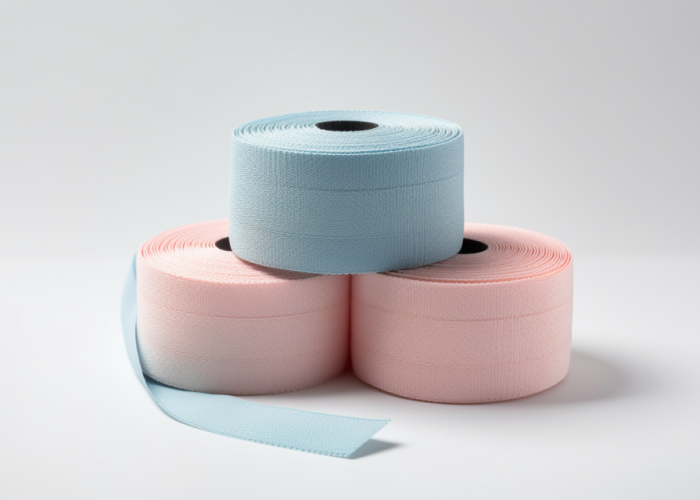Proper fetal monitoring requires secure attachment of sensors to the maternal abdomen throughout pregnancy and labor. Medical professionals need reliable straps that balance sensor stability with patient comfort for accurate monitoring outcomes.
A fetal monitoring strap is a specialized webbing band that secures electronic monitoring sensors to a pregnant woman’s abdomen. Made from hypoallergenic, elastic materials, these straps maintain consistent sensor contact while providing comfort during extended monitoring periods, balancing durability with skin sensitivity for optimal clinical performance.
Discover key materials, design specs, and standards for fetal monitoring straps tailored to meet medical and maternal-fetal monitoring requirements.


Webbing manufacturing expert with 15+ years of experience helping product developers build high-performance straps for industrial, medical, and outdoor use.
Fetal monitoring straps are typically made from elastic webbing materials including nylon, polyester, and specialized medical-grade elastics that offer controlled stretch properties. These materials balance tension for secure monitoring device attachment while ensuring patient comfort during extended monitoring periods.
Material selection focuses on patient comfort and functional performance. Medical-grade materials must be hypoallergenic for sensitive skin, particularly important during pregnancy when skin sensitivity often increases. Materials undergo treatments to remain soft against the skin while maintaining appropriate elasticity and breathability to reduce perspiration that could cause irritation or compromise sensor contact.
Elasticity control is crucial, with materials typically providing 20-30% elasticity for optimal sensor contact without excessive pressure. Advanced designs incorporate varying elastic zones to maintain consistent pressure across different abdominal contours. Meanwhile, durability considerations ensure straps withstand repeated use, frequent cleaning with disinfectants, and exposure to bodily fluids.
Recent innovations include antimicrobial treatments to reduce infection risks and moisture-wicking properties for enhanced comfort during extended monitoring. Manufacturers increasingly develop sustainable material options that maintain clinical performance while addressing environmental concerns.
Key Takeaways:
• Medical-grade elastics provide controlled stretch (20-30%) for secure sensor contact
• Hypoallergenic materials are essential for sensitive pregnancy skin
• Moisture management and breathability prevent skin irritation
• Durability features include resistance to disinfectants and bodily fluids
• Antimicrobial treatments enhance infection control in clinical settings
Skin contact and durability considerations directly influence fetal monitoring strap design through material selection, edge treatment methods, and pressure distribution systems. Effective designs balance firm sensor contact with skin protection during extended monitoring while ensuring sufficient durability for clinical use.
Patient comfort is paramount, especially during monitoring sessions lasting 8-12 hours or more. Designs with wider contact areas distribute pressure evenly across the skin surface, reducing localized irritation. Effective moisture management incorporates wicking properties and breathable structures that allow airflow while maintaining appropriate tension.
Adaptability to different body types requires designs with multi-point adjustability for customized fitting. Some advanced systems include differential tension zones that automatically adjust to maintain consistent pressure despite varying anatomical contours during pregnancy.
For clinical durability, designs must resist degradation from cleaning chemicals, bodily fluids, mechanical stress, and repeated use. Advanced options incorporate reinforced attachment points, chemical-resistant materials, and construction techniques preventing delamination or structural failure throughout the product lifecycle.
Key Takeaways:
• Wide contact surfaces distribute pressure evenly to prevent irritation
• Moisture management features reduce skin problems during extended wear
• Multi-point adjustability accommodates diverse patient body types
• Reinforced attachment points enhance durability in clinical settings
• Seamless construction improves infection control and prevents contamination

Fetal monitoring strap sizes vary based on patient population, monitoring duration, and specific clinical application, typically categorized as standard adult, bariatric, and pediatric/neonatal sizes. These variations accommodate different abdominal circumferences from under 60cm to over 150cm, ensuring proper sensor placement and consistent contact.
Standard adult sizing typically accommodates abdominal circumferences between 80-120cm, with adjustment mechanisms allowing 20-30% variation within each size category. Bariatric sizing features extended length (120-150cm or more) with specialized distribution systems preventing rolling or bunching. Pediatric applications use smaller straps (40-60cm) with proportionally reduced width and increased softness.
Adjustability mechanisms significantly impact clinical utility, ranging from basic hook-and-loop fasteners to advanced multi-point adjustment systems allowing customization of both circumference and tension distribution. Some designs feature quick-release mechanisms for emergency situations.
Proper sizing directly impacts monitoring accuracy, with studies showing appropriate sizing reduces monitoring interruptions by 30-40% compared to one-size-fits-all approaches, translating to enhanced clinical outcomes through more consistent fetal surveillance.
Key Takeaways:
• Standard sizes (80-120cm) accommodate most maternal patients
• Bariatric designs (120-150cm+) include roll-prevention features
• Pediatric sizes (40-60cm) feature increased softness for sensitive patients
• Multi-point adjustment enables customized tension distribution
• Proper sizing reduces monitoring interruptions by 30-40%
Color-coding standards for fetal monitoring straps typically follow systematic classification systems based on size, application type, or monitoring duration. Common standards use blue for standard adult sizes, yellow for pediatric applications, and red for emergency or specialized monitoring scenarios, enhancing workflow efficiency in clinical environments.
Color-coding enables immediate visual identification in busy settings, reducing cognitive load during equipment selection. Studies show standardized color systems can reduce selection errors by up to 40% in high-stress environments. Size differentiation typically uses blue/green for standard adult sizes, purple/orange for bariatric, and yellow/pink for pediatric/neonatal applications.
Application-specific coding differentiates between short-term and extended use straps, while specialized monitoring scenarios like emergency situations or water-birth applications use distinct colors for immediate recognition. Implementation consistency across departments and equipment types is crucial for maintaining the cognitive advantages of color-based identification.
Key Takeaways:
• Blue/green typically indicates standard adult sizing
• Yellow/pink commonly denotes pediatric applications
• Red often signifies emergency or specialized monitoring
• Color-coding reduces selection errors by up to 40%
• Standardized implementation across departments maximizes benefits

Specialized fixation systems for fetal monitoring straps include adjustable tensioning mechanisms, quick-release connectors, and multi-point attachment designs. These systems enhance monitoring reliability while improving patient comfort during extended observation periods.
Advanced designs incorporate ratcheting mechanisms for precise tension adjustment at multiple points, distributing pressure evenly across the abdomen. Quick-deployment systems feature simplified application for emergency scenarios, while quick-release mechanisms facilitate immediate removal when necessary.
Multi-sensor accommodation designs incorporate designated positioning elements for different sensor types, ensuring optimal placement relative to anatomical landmarks. Mobility-enhanced systems use flexible materials and articulated attachment points to maintain sensor contact despite patient movement, with some waterproof designs accommodating hydrotherapy during labor.
Sensor-specific attachment mechanisms optimize monitoring quality by providing tailored interfaces for ultrasound transducers, tocodynamometry, or specialized sensors, enhancing signal quality while reducing motion artifacts.
Key Takeaways:
• Multi-point tensioning systems distribute pressure evenly
• Quick-release mechanisms facilitate emergency interventions
• Modular designs accommodate multiple sensor types
• Flexible construction maintains monitoring during patient movement
• Specialized interfaces reduce motion artifacts for cleaner signals
Fetal monitoring straps must comply with medical device regulations including FDA classification requirements, ISO 13485 quality management standards, and biocompatibility testing protocols. These frameworks establish minimum requirements for materials, manufacturing processes, and performance characteristics to ensure patient safety.
FDA classifies these products as Class II medical devices requiring 510(k) premarket notification, demonstrating safety and effectiveness through comparative testing against predicate devices. International standards like ISO 13485:2016 establish quality management system requirements for consistent product quality across markets.
Biocompatibility testing per ISO 10993 standards is critical for patient-contact devices, requiring verification of cytotoxicity, sensitization, and irritation potential. Extended contact duration (often 24+ hours) places these products in prolonged contact categories needing additional verification.
Material safety documentation must demonstrate the absence of harmful substances including phthalates, latex, and endocrine-disrupting chemicals. Quality system requirements establish consistent manufacturing processes through documented procedures, validation protocols, and quality control checks throughout production.
Key Takeaways:
• FDA classifies fetal monitoring straps as Class II medical devices
• 510(k) premarket notification requires predicate device comparison
• ISO 10993 biocompatibility testing ensures patient safety
• Documentation must verify absence of latex and harmful chemicals
• Quality management systems must comply with ISO 13485:2016
Fetal monitoring straps require specialized materials, precise design considerations, and regulatory compliance to ensure optimal performance in clinical settings. As a custom webbing manufacturer, we can develop tailored fetal monitoring strap solutions that meet your specific requirements for elasticity, comfort, durability and regulatory standards. Partner with us to enhance your medical device performance through customized webbing technology.
Color-coded fetal monitoring straps improve workflow efficiency, reduce selection errors by up to 40%, and enhance patient safety through immediate visual identification. Standardized color systems allow clinicians to quickly identify appropriate sizes and applications, particularly valuable during emergency situations. Color-coding also facilitates inventory management and appropriate deployment across different clinical departments.
The durability of fetal monitoring straps is determined by material composition, reinforced attachment points, and chemical resistance properties. Medical-grade elastic webbing with sealed edges resists degradation from repeated disinfection and exposure to bodily fluids. Properly constructed straps maintain their elasticity and performance characteristics for hundreds of clinical use cycles.
Yes, hypoallergenic materials specifically designed for sensitive skin include medical-grade silicone-infused elastics and specialized polyester blends with non-reactive properties. These materials undergo extensive biocompatibility testing to ISO 10993 standards, ensuring minimal irritation risk during extended monitoring sessions. Many manufacturers offer latex-free options to prevent allergic reactions in sensitive patients.
Monitoring accuracy directly correlates with proper strap sizing, with appropriately sized straps reducing signal artifacts by up to 40% compared to improperly sized alternatives. Correct sizing ensures optimal sensor positioning relative to fetal position, maintaining consistent contact pressure throughout movement. Clinical studies indicate that proper strap selection significantly improves trace quality and reduces monitoring interruptions.
Yes, selection guidelines recommend considering abdominal circumference, monitoring duration, patient mobility needs, and skin sensitivity factors. Bariatric patients require specialized designs preventing roll-down, while patients with sensitive skin benefit from hypoallergenic materials. Extended monitoring sessions call for breathable materials with enhanced moisture management, while active patients need flexible designs maintaining sensor contact during movement.
Key regulatory considerations include FDA Class II medical device requirements, 510(k) premarket notification, ISO 13485 quality management compliance, and comprehensive biocompatibility testing. Manufacturers must document all materials, establish robust quality control processes, and demonstrate performance equivalent to predicate devices. Ongoing post-market surveillance and complaint handling systems are mandatory for maintaining regulatory compliance.